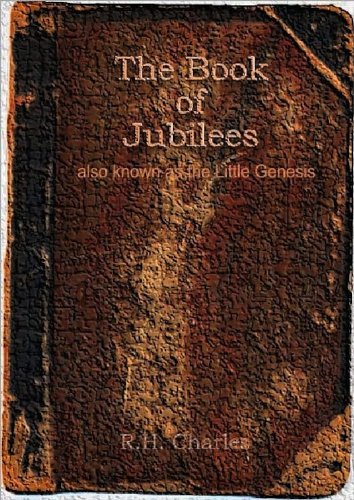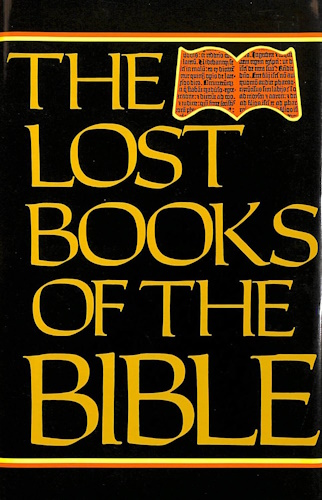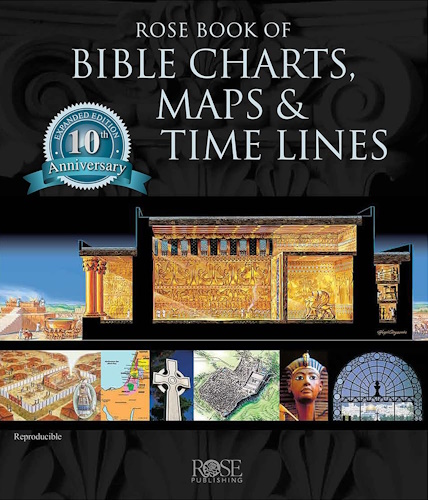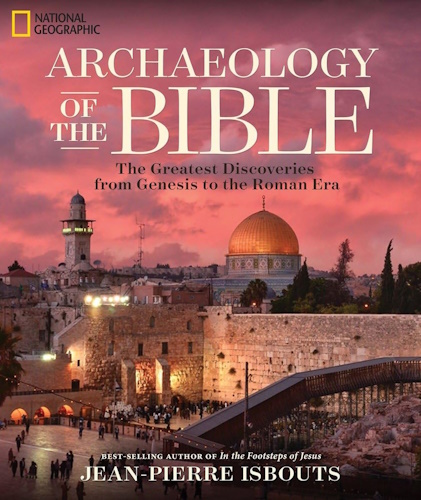
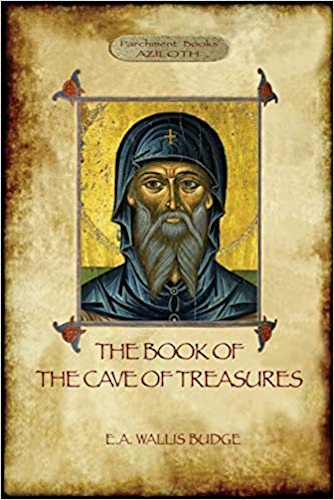
The Book Of The Cave Of Treasures
A History Of The Patriarchs And The Kings
Their Successors From The Creation
To The Crucifixion Of Christ
by
Sir E.A. Wallis Budge, KT.
M.A., LITT.D. (CAMBRIDGE), M.A., D.LITT. (OXFORD),
D.LIT. (DURHAM), F.S.A.
![]()
![]()
p. 273
ABRAHAM AND THE CITY OF UR.
The paragraphs which the author of the "Cave Treasures" devotes to the history of Terah and Abraham throw new light upon the lives of these patriarchs and the conditions under which they lived in the city of Ur, and they contain many interesting details which are not recorded in the Book of Genesis, and some new information concerning the overthrow of the city of Ur by the "Wind Flood." It is quite clear that Terah and Abraham were great, powerful and wealthy shêkhs, and their large flocks of sheep and goats and herds of camels suggest that they were owners and breeders of cattle on a large scale, and masters of caravans. The three hundred and eighteen trained men, born in his house (Gen. xiv. 14), whom Abraham armed and sent forth to rescue Lot, his nephew, were probably the armed guards who marched with his flocks and herds and caravans and protected them. Up to the present no person
p. 274
mentioned in the cuneiform inscriptions can be identified either with Terah or Abraham, but all the facts which the recent excavations at Ur have brought to light show that in Abraham's day the inhabitants of the city were given up wholly to idolatry, their chief object of worship being Nannar, the Moon-god. Not only did Abraham smash his father's idols, but under the divine guidance he freed himself from the custom of offering up his firstborn to devils. Further, when he saw his city attacked by hosts of enemies from the north and from the low-lying lands to the south, there was nothing left for him to do but migrate to the country which God promised to give him. Putting all the evidence together, it is clear that Abraham was a great, strong and independent chief in Babylonia, and that his power waxed greater when he established himself at Harrân. The rescue of Lot shows that his armed retainers formed an effective military body, and the greatness of his might and influence is proved by the fact that he compelled Ephron the Hittite to sell him the cave of Machpelah. And the Pharaoh, king of Egypt, who seized Sarah, would hardly have listened to Abraham's objections unless he knew that Abraham had a following strong enough to make his restitution of Sarah a necessity.
p. 275
THE EXCAVATIONS AT UR OF THE CHALDEES.
Of the greatness and importance of Ur of the Chaldees politically and commercially, the excavations which Mr. C. L. Woolley has conducted for the British Museum and the University of Pennsylvania during the last five years afford abundant evidence. In my little book, Babylonian Life and History, London, 1925, I gave a brief summary of what had been done up to the time of going to press, and it is necessary to describe the progress of the work during the winters of 1924-25 and 1925-26. The facts are derived from Mr. Woolley's official reports, published in the Antiquaries' Journal, Vol. V, No. 4, and Vol. VI, No. 4. As already said, the Ziggurat which stands in the west corner of the Temenos enclosure was cleared during the winter of 1923-24, and in 1924-25 work was begun on the Temenos or Sacred Area itself. A good general view of the site already excavated is given on Plate III. Already in 1925, Mr. Woolley was able to report as follows: "Summarizing our results in this part of the field, we can say that we have now a complete plan of the Ziggurat and its surroundings in the Neo-Babylonian period after the wholesale reconstructions of Nebuchadnezzar II and Nabonidus, the complete plan of the Kassite period for three
p. 276
sides of the Ziggurat, a good part of the plan of the buildings of the Larsa period (2000 B.C.), and that of Ur-Engur's (i.e. Ur-Nammu's) work on one side of the tower, together with a general idea of its lines on two of the other sides." The Ziggurat of Ur-Nammu was built on a terrace which on this side had a width of 34 metres, and cones of baked clay bearing Ur-Nammu's dedication of the building E-temen-ni-il had been inserted in the vertical joints of the brickwork. For the first time these cones were found in their original position. A specimen of these cones is given on Plate IV. Ur-Nammu built E Nannar, or Temple of the Moon-god, on the terrace level of E-temen-ni-il. During the Larsa period Ur-Nammu's buildings were reconstructed, and prominent among the kings who carried out this work were Sinidinnam (2086-2080 B.C.) and Warad Sin (2072-2060 B.C.). Cones and other monuments show that En-an-na-tum, high-priest of Nannar, and son of king Ishme-Dagan, and Sumu-ilum, who built a temple to Innina, and Silli-Adad, and Kudur Mabug had all worked here.
The principal builder at Ur during the Kassite period was Kuri-Galzu, but his work was not of the best kind, and as his successors did no repairs on his buildings, they fell into decay. The arched doorway which he built in the
p. 277
sanctuary of E-Dublal-maḫ is shown on Plate IV. For seven hundred years nothing of importance in connection with the temple buildings at Ur was done. Nebuchadnezzar II and his grandson practically rebuilt the public buildings at Ur. They found the ancient shrines so hopelessly destroyed or so completely buried that on a traditional site they were able to employ a new design or radically to reshape the old, and even to change the location of a sanctuary whose name alone perhaps survived. Under the rule of the Persians the city gradually sunk into ruin and decay.
To the south-east of the Ziggurat stood the Temple of Nin-gal, which was built by Sinbalatsu-ikbi (see the door socket of this king on Plate VIII), the Assyrian governor of Ur (650 B.C.), and was restored by Nabonidus. Mr. Woolley's excavations showed that it was built on the site of the first temple of Nin-gal, which dated from the reign of Kuri-Galzu in the XIVth century B.C.
To the south-east of the temple E-Nun-Mah are the temple E-Dublal-Mah, the work of Kuri-Galzu (Plate V), and the E-Gig-Par which was built by Nabonidus (Plate VI). The latter building is 95 metres long and 50 metres wide, and is oriented N.W. and S.E., and there is no doubt that it was the
p. 278
convent in which Bêl-Shalti-Nannar, daughter of Nabonidus and sister of Belshazzar, ruled as Lady Superior of the sacred women of Ur. In the rooms of this convent were found a very large number of small but important objects, e.g. gate sockets, sculptured reliefs, school-exercise tablets, teaching tablets, tablets marked with squares in lines used in playing games, etc., and one room was used as a Museum, for it contained inscribed objects with labels attached for teaching purposes! The remains found in E-Dublal-Mah included portions of a statue, dating from 2800 B.C.; a limestone plaque with reliefs representing the worship of Nannar (Plate XIII, No. 1); portions of the great stele of Ur-Nammu (Plate XI, No. 2); alabaster rams forming the sides of a throne (Plate XIII, No. 2); etc.
During the winter of 1925-26, Mr. Woolley and his men excavated the great Gig-Par-ku site at Ur. The earliest buildings of which any actual ruins were found belonged to the period of the First Dynasty of Ur (about 4000-3500 B.C.). In digging down to trace the Third Dynasty foundations, they found a short section of a wall constructed with kiln-burnt plano-convex bricks set over a foundation of rough limestone blocks, a wall identical in every respect with that of the temple built by king
p. 279
A-an-nî-pad-da at Al-`Ubêd. Among the buildings of the Third Dynasty of Ur (2300 B.C.) was the temple of Ur-Nammu, but remains of its walls are wanting. Thirteen gate sockets were found, and the inscription on them reads, "Ur-Nammu, the mighty man, the king of Ur, the king of Sumer and Akkad, has built the splendid Gig-Par for his Lady Nin-Gal" (Plate VII, Nos. 2 and 3). On the ruins of Ur-Nammu's temple his grandson Bur-Sin built a temple which was dedicated by him to the goddess Nin-Gal. An inscribed door socket of Bur-Sin is shown on Plate VIII. This temple was probably destroyed about 2000 B.C. by the Elamites, who captured the city and brought the rule of the Third Dynasty of Ur to an end.
The next temple that occupied the site was built by En-an-na-tum, son of Ishme-Dagan, king of Isin. The building was rectangular and measured 79 metres by 76½ metres, and its angles were oriented to the cardinal points of the compass. It was surrounded by a massive wall, and had two entrances; at the east angle was a gate tower. The building was divided into three parts by the cross corridor, and by a wall running parallel with it; it contained two temples, several small shrines, and a considerable number of small rooms, in which the priests and priestesses lived. Some of the rooms were used
p. 280
as kitchens and pantries, and some as sepulchral chambers in which the bodies of dead priests were buried. A view of the great kitchen in Gig Par Ku is given on Plate IX. The building supplies a complete plan of an early Sumerian sanctuary, which has hitherto been wanting. The temple flourished in a greater or lesser degree all through the reign of Hammurabi, and down to the eleventh year of the reign of his son Samsu-iluna; its destruction probably took place during, or as a result of, the revolt which took place in the following year. Among the important objects found in the ruins may be mentioned:--1. A diorite statuette of the goddess Eau, the great "World- Mother" (Plate X), which was made about 2400 B.C. 2. Diorite statuette of the goddess Nin-Gal (about 2080 B.C.). 3. A limestone plaque on which are sculptured scenes of worship (about 3000 B.C.) (Plate XI, No. 1). 4. An alabaster model of the lunar disk dedicated to Nannar by the daughter of Sargon of Agade (about 2630 B.C.). 5. A granite bowl of Naram-Sin of Agade (2550 B.C.), which about 300 years later (about 2250 B.C.) was presented to the temple at Ur by the daughter of king Dungi (or, Shulgi).
The excavation of the "Palace Site "has yielded much useful information, and the further exploration of the so-called Tomb Mound has
p. 281
laid bare the foundations of many houses, and yielded many small, but interesting, antiquities, tablets, terra-cotta figures, cylinder seals, pottery, etc. Among the tablets were several dating from the period of Rim-Sin (1980 B.C.); these were inscribed with hymns and religious texts written in honour of the Moon-god Nannar.
Mr. C. L. Woolley resurned work at Ur on October 28, 1926, and continued the excavations until February, 1927, when want of funds brought his operations to a standstill. The results of his labours during the past winter are of extraordinary importance, and through the courtesy of Sir Frederic Kenyon, Director of the British Museum, and the late Dr. Byron Gordon, Director of the Museum of the University of Pennsylvania at Philadelphia, I am enabled to describe them briefly in the following pages.
The site first selected for work during the past winter was a lofty mound outside the wall built by Nebuchadnezzar II round the Sacred Area, and when a space measuring 200 feet by 150 feet was cleared, several blocks of houses, divided by narrow streets, were found. Hitherto the Expedition had excavated only temples and fortifications which, after all, tell us little or nothing about the private daily life of Abraham's neighbours, but Mr. Woolley felt that the time had come for him to explore the ruins of the
p. 282
houses of the merchants and the poorer class of inhabitants of "Ur of the Chaldees," and the results he obtained greatly exceeded his expectations. When a house fell down in Babylonia the ruins were levelled and another house was built on them, and in some mounds several layers of houses, each layer belonging to a different period, have been identified. On the site selected by Mr. Woolley the rains and winds and storms of four thousand years had removed all the more modern layers of houses, and he was able to get to work at once on a fine collection of houses which were built about 2100 B.C. The main walls being built of burnt brick, were in a good state of preservation; the interior walls were of mud brick, laid on burnt brick foundations, which rose two or three feet above the brick-paved floor. Thus the foundations formed a "damp course," and the state of the walls showed that the dwellers in the houses were not troubled by damp. The visitor, on passing through the doorway, entered a small ante-chamber, which led into the courtyard; this was partly covered in. The reception room was on one side, and the kitchen and pantry, etc., were on the other. The bedrooms of the family were on the upper floor, which were entered from a wooden gallery running round all four sides of the court yard.
p. 283

p. 284
Close to the front door was the stairway, the treads of which are made of solid brick. The walls of these houses are still about 20 feet in height, and the plan of them and the general arrangement of the rooms on the ground floor and upper floor are reproduced to this day in the houses of merchants and well-to-do folk at Baghdâd and Hillah. There is little doubt that it was in houses of this kind that Serug, Terah, Nahor and Abraham lived. The houses and their courtyards stood side by side in rows, as at the present day; the streets then as now were narrow. An excellent representation of a street is given on Plate XII. {See page 283 for a drawing of the interior of a private house.}
When the master of the house died he was usually buried under it, together with his engraved stone cylinder-seal, pots, and inscribed clay tablets. As was to be expected, no furniture of any shape or kind was found in the houses, and even the burial places under them had been rifled. But, in spite of this, Mr. Woolley succeeded in collecting from the site a considerable number of clay tablets inscribed with tables of square and cube roots, hymns, and records of the buildings erected by various kings of Ur. Among the miscellaneous objects found may be mentioned a bottle of blue and black glass which probably came from Syria; this interesting object was probably made about 1500 B.C..
p. 285
The works that were carried out after the excavation of the houses was finished threw much light upon the history of Ur in the first half of the third minennium B.C. There is now no doubt that a temple tower or Ziggurat existed at Ur as early as 2800 B.C., for portions of its walls made of plano-convex mud bricks were found buried under the Ziggurat made by Ur-Nammu 2600 B.C. Under the temple of E-nin-makh a very interesting object was discovered in the shape of the cover of an ivory toilet box bearing a Phoenician inscription (see Plate XIV, No. 1), and with it were several articles for the toilet in ivory, and a beautifully engraved comb. The remains of the royal buildings, which were erected about 2000 B.C., prove that the Sumerians, even at that early period, were able to construct halls with arches and vaulted roofs. It is clear that many of the statements which were made by architectural authorities two or three generations ago will have to be greatly modified in the light of the discoveries made at Ur. In a great commercial centre like Ur accurate weights were of prime importance, and the fine diorite duck-weight inscribed with the name of king Shulgi shows that as early as 2500 B.C. standard weights were in use in Babylonia (see Plate VII, No. 1). This standard was in use in Babylonia two thousand years later, as an inscription on a weight of Nebuchadnezzar II testifies.
p. 286
The next portion of the site selected for careful excavation was the area at the south-east end, inside the wall built by Nebuchadnezzar II, where there were no buildings. A trench cut across it brought to light an early cemetery, containing graves which were made not much later than 3000 B.C. These graves yielded a large quantity of pottery; vases in diorite, hard stone, alabaster, and steatite, many of beautiful shape and design; copper bowls, vases, pots, axe-heads, adzes, spears, razors, knives and daggers; gold, silver and carnelian beads; lapis lazuli pins with heads of gold or silver; cylinder-seals beautifully engraved; rock-crystal cylinder-seals with copper caps and cores made of white or coloured paste; gold tiaras, chains, finger-rings, ear-rings, beads, amulets, etc. All these show that the crafts of the metal worker and the jeweller had reached a very high state of perfection when the first kings of the Ist dynasty of Ur began to reign in the second half of the fourth millennium B.C. When these graves were made they were only about one foot below the level of the surrounding country, but now they lie some 15 or 20 feet under the accumulated rubbish of fifty centuries. The latest graves were, according to Mr. Woolley, made about 3000 B.C., and the earliest some 500 years earlier. Among the objects found in the
p. 287
lowermost layer of graves were two cylinder-seals each inscribed with the name of a king of Ur who reigned over the city several hundreds of years before its history as a great commercial centre began. In the uppermost layer the cylinder-seals are inscribed with the names of officers of the household of the daughter of Sargon of Agade, about 2600 B.C. This princess was the High Priestess of the Moon-god of Ur.
The four principal methods of burial were as follows:--(1) The body, in its ordinary apparel, was wrapped in a mat and laid on a mat at the bottom of the grave; the vases, weapons, ornaments, etc., were placed round about it. (2) The body was placed in a wickerwork coffin, together with the small objects; the vessels in pottery, stone, etc., were grouped round it. (3) The body was laid in a wooden coffin, with the objects to be buried with it, some being enclosed in little coffers. (4) The body was laid in an oval case made of clay. In the oldest graves of all, traces of partial cremation were found. The problem of how the early Sumerians disposed of their dead has now been solved. As the Egyptians buried their dead on the west bank of the Nile, so also did the Sumerians transport the bodies of their dead across the great canal which flowed by the west wall of the city of Ur, and bury them in the western desert.
p. 288
Before the close of the season cylinder-seals bearing the names of five early kings, of whom three were unknown to history, were found. From the lapis lazuli cylinder-seal of Queen Nin-Kur-Nin the name of her husband Mes-anni-padda  , the founder of the Ist dynasty of Ur has been recovered. Several of the kings of this dynasty have hitherto been regarded as mythical.
, the founder of the Ist dynasty of Ur has been recovered. Several of the kings of this dynasty have hitherto been regarded as mythical.
Below the black stratum which lies under the graves of the period of 3000 B.C. the richest graves were found. Here were discovered clay tablets, inscribed with a semi-pictographic script, and seals bearing the names of kings unrecorded in history. Among the other important "finds" may be mentioned:--(1) Eight shell plaques decorated with linear patterns (see Plate XV) and animal figures; the lines are filled in with colour, red and black. (2) A royal gaming board, which consists of 20 shell plaques, decorated with linear designs and inlay of red paste and lapis lazuli, and framed with lapis lazuli, ivory and mother-of-pearl. It is the Sumerian equivalent of the so-called draught-boards which have been found in Egyptian tombs, and seems to indicate that the Sumerians, as well as the Egyptians, believed that their dead amused themselves by playing some game like that of draughts in the Other World.
p. 289
But the greatest "find" of all was made just before the end of the season. About 18 feet below the level of the ground Mr. Woolley came upon a hoard of copper tools and weapons. This consisted of sets of chisels and bundles of heavy spear-heads, and side by side with these were two gold chisels and a gold spear-head. Further research brought to light more copper weapons, arrows by the quiverful, lance-points, a mace, axe-heads, and parts of bows. Round about these were pendants in carnelian, lapis lazuli and gold, the gold binding for a bow, an adze of solid gold, its wooden handle being covered with plaster painted red and bound with thin gold. Lying a little apart was a silver baldric, to which was attached a "vanity case" of gold filigree work, containing a pair of tiny tweezers, spoon and stiletto, all of gold, hung upon a silver ring. Close by was a dagger (see Plate XIV, No. 2). The hilt is formed of one piece of deep-coloured lapis lazuli studded with gold, and the blade is of burnished gold; the sheath is of solid gold. The back of the latter is plain except for two lines of simple beading, but the front is entirely covered with an intricate design in filigree work. The dagger and its sheath are marvels of design and workmanship, and as they were made at least fifty-five centuries ago, they are among the oldest and finest specimens of the craft of the goldsmith in the world.
p. 290
All the more important antiquities which have fallen to the share of the Trustees of the British Museum are exhibited in the Babylonian Rooms of the Museum, and are on view all day and every day. Mr. Woolley has written and published in October each year in The Antiquaries' Journal a detailed report, with excellent plans and a large number of photographic plates, of the work done at Ur during the preceding winter, and to these the reader who requires fuller and more detailed information about the work is begged to refer. The Trustees of the British Museum have also decided to publish a full scientific Report on the work, with maps, plans, and photographs, and the first volume of it, which deals with the discovery of the temple of A-an-ni-pad-da at Tall al-`Ubêd, near Ur, by Dr. H. R. Hall, and the completion of its excavation by Mr. Woolley, has already appeared. A smaller work on the temple of Tall al-`Ubêd is being prepared by Dr. H. R. Hall, and Mr. C. J. Gadd, of the British Museum, is writing the history of Ur from the time of the Seven Wise Men who flourished before the Flood to the final downfall and decay of the city about 300 B.C.
-
Urantia Book, 44:0.11 - The Celestial Artisans
Never in your long ascendancy will you lose the power to recognize your associates of former existences. Always, as you ascend inward in the scale of life, will you retain the ability to recognize and fraternize with the fellow beings of your previous and lower levels of experience. Each new translation or resurrection will add one more group of spirit beings to your vision range without in the least depriving you of the ability to recognize your friends and fellows of former estates.
-
Princess Bride 1987 Wallace Shawn (Vizzini) and Mandy Patinkin (Inigo Montoya)
Vizzini: HE DIDN'T FALL? INCONCEIVABLE.
Inigo Montoya: You keep using that word. I do not think it means what you think it means. -
Urantia Book, 117:4.14 - The Finite God
And here is mystery: The more closely man approaches God through love, the greater the reality -- actuality -- of that man. The more man withdraws from God, the more nearly he approaches nonreality -- cessation of existence. When man consecrates his will to the doing of the Father's will, when man gives God all that he has, then does God make that man more than he is.
-
Urantia Book, 167:7.4 - The Talk About Angels
"And do you not remember that I said to you once before that, if you had your spiritual eyes anointed, you would then see the heavens opened and behold the angels of God ascending and descending? It is by the ministry of the angels that one world may be kept in touch with other worlds, for have I not repeatedly told you that I have other sheep not of this fold?"
-
Urantia Book, Foreword - 0:12.12 - The Trinities
But we know that there dwells within the human mind a fragment of God, and that there sojourns with the human soul the Spirit of Truth; and we further know that these spirit forces conspire to enable material man to grasp the reality of spiritual values and to comprehend the philosophy of universe meanings. But even more certainly we know that these spirits of the Divine Presence are able to assist man in the spiritual appropriation of all truth contributory to the enhancement of the ever-progressing reality of personal religious experience—God-consciousness.
-
Urantia Book, 1:4.3 - The Mystery Of God
When you are through down here, when your course has been run in temporary form on earth, when your trial trip in the flesh is finished, when the dust that composes the mortal tabernacle "returns to the earth whence it came"; then, it is revealed, the indwelling "Spirit shall return to God who gave it." There sojourns within each moral being of this planet a fragment of God, a part and parcel of divinity. It is not yet yours by right of possession, but it is designedly intended to be one with you if you survive the mortal existence.
-
Urantia Book, 1:4.1 - The Mystery Of God
And the greatest of all the unfathomable mysteries of God is the phenomenon of the divine indwelling of mortal minds. The manner in which the Universal Father sojourns with the creatures of time is the most profound of all universe mysteries; the divine presence in the mind of man is the mystery of mysteries.
-
Urantia Book, 1:4.6 - The Mystery Of God
To every spirit being and to every mortal creature in every sphere and on every world of the universe of universes, the Universal Father reveals all of his gracious and divine self that can be discerned or comprehended by such spirit beings and by such mortal creatures. God is no respecter of persons, either spiritual or material. The divine presence which any child of the universe enjoys at any given moment is limited only by the capacity of such a creature to receive and to discern the spirit actualities of the supermaterial world.
-
Urantia Book, 11:0.1 - The Eternal Isle Of Paradise
Paradise is the eternal center of the universe of universes and the abiding place of the Universal Father, the Eternal Son, the Infinite Spirit, and their divine co-ordinates and associates. This central Isle is the most gigantic organized body of cosmic reality in all the master universe. Paradise is a material sphere as well as a spiritual abode. All of the intelligent creation of the Universal Father is domiciled on material abodes; hence must the absolute controlling center also be material, literal. And again it should be reiterated that spirit things and spiritual beings are real.
-
Urantia Book, 50:6.4 - Planetary Culture
Culture presupposes quality of mind; culture cannot be enhanced unless mind is elevated. Superior intellect will seek a noble culture and find some way to attain such a goal. Inferior minds will spurn the highest culture even when presented to them ready-made.
-
Urantia Book, 54:1.6 - True And False Liberty
True liberty is the associate of genuine self-respect; false liberty is the consort of self-admiration. True liberty is the fruit of self-control; false liberty, the assumption of self-assertion. Self-control leads to altruistic service; self-admiration tends towards the exploitation of others for the selfish aggrandizement of such a mistaken individual as is willing to sacrifice righteous attainment for the sake of possessing unjust power over his fellow beings.
-
Urantia Book, 54:1.9 - True And False Liberty
How dare the self-willed creature encroach upon the rights of his fellows in the name of personal liberty when the Supreme Rulers of the universe stand back in merciful respect for these prerogatives of will and potentials of personality! No being, in the exercise of his supposed personal liberty, has a right to deprive any other being of those privileges of existence conferred by the Creators and duly respected by all their loyal associates, subordinates, and subjects.
-
Urantia Book, 54:1.8 - True And False Liberty
There is no error greater than that species of self-deception which leads intelligent beings to crave the exercise of power over other beings for the purpose of depriving these persons of their natural liberties. The golden rule of human fairness cries out against all such fraud, unfairness, selfishness, and unrighteousness.









